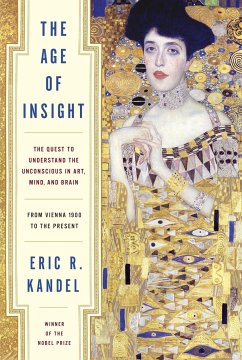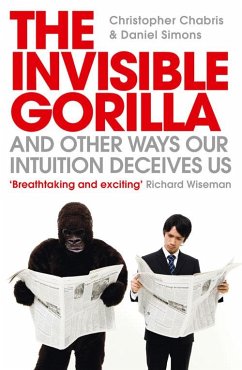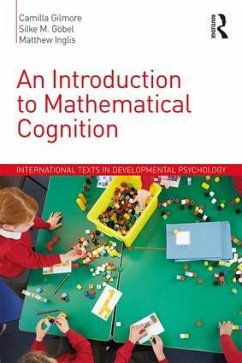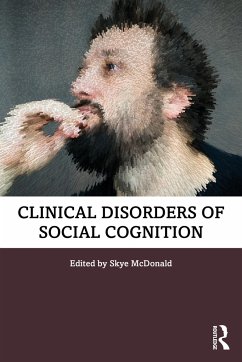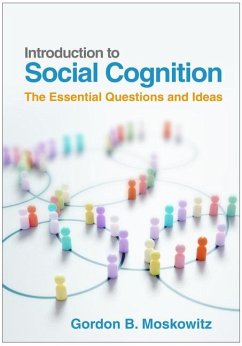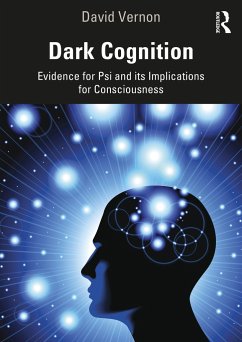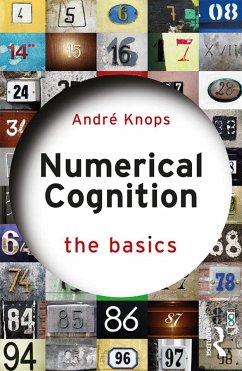Nicht lieferbar
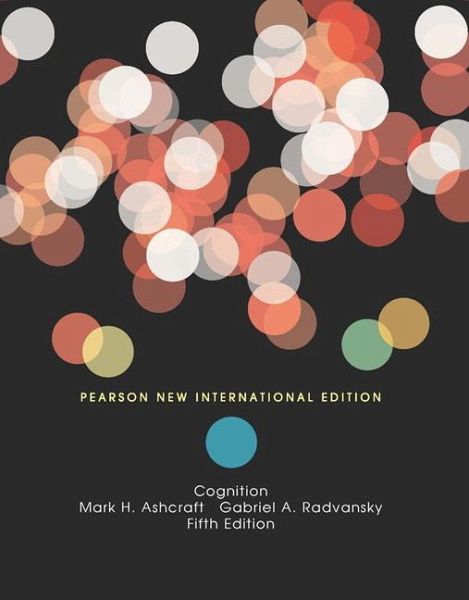
Cognition
Pearson New International Edition
Versandkostenfrei!
Nicht lieferbar
For undergraduate level courses in Cognition and Theories of Learning.
The psychology of human memory and cognition is fascinating, dealing with questions and ideas that are inherently interesting, such as how we think, reason, remember, and use language. Using a first person narrative, posing direct questions to the reader, and balancing classic research with cutting edge topics, the author draws in the reader and conveys the excitement of the field.
Reflecting the increasing use of new technologies to study memory and cognition, Ashcraft and the new co-author, Gabriel Radvansky, continue to integrate sections on neurosciences within individual chapter topics.
Features + Benefits
Create a Custom Text: For enrollments of at least 25, create your own textbook by combining chapters from best-selling Pearson textbooks and/or reading selections in the sequence you want. To begin building your custom text, visit www.pearsoncustomlibrary.com. You may also work with a dedicated Pearson Custom editor to create your ideal text–publishing your own original content or mixing and matching Pearson content. Contact your Pearson Publisher’s Representative to get started.
Provide student with the most up-to-date research and material:
Thoroughly revised and updated throughout—i.e., false memory research; working memory and individual differences; online investigations of comprehension and reading; and new challenges to the classic research on heuristics in decision making— this offers students current and additional material on important topics and developments central to the field.
Over 300 new reference citations since the 2002 edition to ensure coverage of cutting edge topics.
Provide students with foundation to be successful in studying cognition:
Sections on neurocognition are integrated within the individual chapter topics. This shows students how integral the neurosciences are to cognitive science.
Background information on neurons and the brain (chapter 2) prepares students—without formal coursework on the biological basis of cognition– for the neurocognitive evidence they will encounter throughout the book.
Accessible writing style draws students into the material so that they can absorb and retain material more easily.
Balance of classic research and current topics presents students with a manageable mix of material that encourages them to read and remember material.
In-depth coverage of treated topics provides students with thorough coverage of the most important subject areas.
Pedagogical Features:
Prove It boxes give students a demonstration project that illustrates the points made.
Critical terms are highlighted to help students master the terminology.
Section Summaries enable students to check their understanding and retention of concepts after each major chapter section.
Glossary
1. Cognitive Psychology : An Introduction
Thinking About Thinking
Memory and Cognition Defined
An Introductory History of Cognitive Psychology
Anticipations of Psychology
Early Psychology
Behaviorism and Neobehaviorism
Dissatifaction with Behaviorism: The Winds of Change
Cognitive Psychology and Information Processing
The New Direction
The Assumptions of Cognitive Psychology
2. The Cognitive Science Approach
Guiding Principles
Themes
Measuring Information Processes
Getting Started
Time and Accuracy Measures
Guiding Analogies
The Information-Processing Approach
The Standard Theory
A Process Model
The Strict Information Processing Approach
Some Difficulties
The Modern Cognitive Approach: Cognitive Science
Updating the Standard Theory
Fixing the Narrowness
Neurocognition: The Brain and Cognition Together
Basic Neurology
Brain Anatomy
Principles of Functioning
Split Brain Research and Lateralization
Methods of Investigation
Neural Net Models: Connectionism
3. Perception and Pattern Recognition
Visual Perception
Gathering Visual Information
Visual Sensory Memory
The Early parts of a Fixation
A Summary for Visual Sensory Memory
Trans-saccadic Memory
Pattern Recognition: Written Language
Gestalt Grouping Principles
The Template Approach
Visual Feature Detection
Beyond Features: Conceptually Driven Pattern Recognition
Connectionist Modeling
Object Recognition and Agnosia
Recognition by Components
Agnosia
Implications for Cognitive Science
Auditory Perception
Auditory Sensory Memory
Auditory Pattern Recognition
4. Attention
Multiple Meaning of Attention
Basics of Attention
Basic Input Attentional Processes
Alertness and Arousal
Orienting Response and Attention Capture
Spotlight Attention and Visual Search
Contrasting Input and Controlled Attention
Hemineglect: An Attention Deficit
Controlled, Voluntary Attention
Selective Attention and the Cocktail Party Effect
Selection Models
Attention as a Mental Resource
Automatic and Conscious Processing Theories
A Synthesis for Attention and Automaticity
Disadvantages of Automaticity
5. Short-Term Working Memory
Short-Term Memory: A Limited Capacity Bottleneck
The Magical Number Seven, Plus or Minus Two
Forgetting from Short-Term Memory
Short-Term Memory Retrieval
Serial Position Effects
Short-Term Memory Scanning: The Sternberg Task
Working Memory
The Components of Working Memory
The Central Executive
The Phonological Loop
The Visuo-Spatial Sketchpad
The Episodic Buffer
Assessing Working Memory
The Dual Task Method
Working Memory Span
The Role of Working Memory in Cognition
Working Memory and Attention
Working Memory and Long-Term Memory
Working Memory and Reasoning
Sometimes Small Working Memory Spans are Better
6. Learning and Remembering
Preliminary Issues
Mnemonic Devices
The Ebbinghaus Tradition of Memory Research
Metamemory
Storing Information in Episodic Memory
Rehearsal
Frequency of Rehearsal
Two Kinds of Rehearsal
Depth of Processing
Challenges to Depth of Processing
Generation and Enactment
Organization in Storage
Imagery
Emotion and Survival Value
Context and Encoding Specificity
Retrieving Episodic Information
Decay
Interference
Retrieval Failure
Retrieval Cues
Amnesia and Implicit Memory
Dissociation of Episodic and Semantic Memory
Anterograde Amnesia
Implicit and Explicit Memory
7. Knowing
Semantic Memory
The Collins and Quillian ( and Loftus) Model
Smith's Feature Comparison Model
Empirical Tests of Semantic Memory Models
Semantic Relatedness
Priming in Semantic Memory
Nuts and Bolts of Priming Tasks
Empirical Demonstrations of Priming
Priming in Other Tasks
Automatic and Controlled Priming
Priming Is an Implicit Process
Schemata and Scripts
Bartlett’s Research
Schemata
Scripts
Evidence of Scripts
< Context, Connectionism, and the Brain
Connectionism
Connectionism and the Brain
8. Using Knowledge in the Real World
The Seven Sins of Memory
Facts About the World
The Nature of Propositions
Rules for Deriving Propositions
Are Propositions Real?
Situation Models and Embodied Cognition
Levels of Representation
Remembering Facts
Metamemory
Source Monitoring
Prospective Memory
Knowing What You Know
False Memories, Eyewitness Memory. and "Forgotten Memories"
False Memories
Integration
Leading Questions and Memory Distortion
The Misinformation Effect
Source Misattribution and Misinformation Acceptance
Stronger Memory Distortion Effects
Repressed and Recovered Memories
Autobiographical Memories
The Bahrick Work
Phenomena of Autobiographical Memory
The Irony of Memory
9. Language
Linguistic Universals and Functions
Defining Language
Language Universals
Animal Communication
Levels of Analysis, a Critical Distinction, and the Sapir-Whorf Hypothesis
Phonology: The Sounds of Language
Sounds in Isolation
Combining Phonemes into Words
Embodiment in Speech Perception
Speech Perception and Context
A Final Puzzle
Syntax: The Ordering of Words and Phrases
Choms
The psychology of human memory and cognition is fascinating, dealing with questions and ideas that are inherently interesting, such as how we think, reason, remember, and use language. Using a first person narrative, posing direct questions to the reader, and balancing classic research with cutting edge topics, the author draws in the reader and conveys the excitement of the field.
Reflecting the increasing use of new technologies to study memory and cognition, Ashcraft and the new co-author, Gabriel Radvansky, continue to integrate sections on neurosciences within individual chapter topics.
Features + Benefits
Create a Custom Text: For enrollments of at least 25, create your own textbook by combining chapters from best-selling Pearson textbooks and/or reading selections in the sequence you want. To begin building your custom text, visit www.pearsoncustomlibrary.com. You may also work with a dedicated Pearson Custom editor to create your ideal text–publishing your own original content or mixing and matching Pearson content. Contact your Pearson Publisher’s Representative to get started.
Provide student with the most up-to-date research and material:
Thoroughly revised and updated throughout—i.e., false memory research; working memory and individual differences; online investigations of comprehension and reading; and new challenges to the classic research on heuristics in decision making— this offers students current and additional material on important topics and developments central to the field.
Over 300 new reference citations since the 2002 edition to ensure coverage of cutting edge topics.
Provide students with foundation to be successful in studying cognition:
Sections on neurocognition are integrated within the individual chapter topics. This shows students how integral the neurosciences are to cognitive science.
Background information on neurons and the brain (chapter 2) prepares students—without formal coursework on the biological basis of cognition– for the neurocognitive evidence they will encounter throughout the book.
Accessible writing style draws students into the material so that they can absorb and retain material more easily.
Balance of classic research and current topics presents students with a manageable mix of material that encourages them to read and remember material.
In-depth coverage of treated topics provides students with thorough coverage of the most important subject areas.
Pedagogical Features:
Prove It boxes give students a demonstration project that illustrates the points made.
Critical terms are highlighted to help students master the terminology.
Section Summaries enable students to check their understanding and retention of concepts after each major chapter section.
Glossary
1. Cognitive Psychology : An Introduction
Thinking About Thinking
Memory and Cognition Defined
An Introductory History of Cognitive Psychology
Anticipations of Psychology
Early Psychology
Behaviorism and Neobehaviorism
Dissatifaction with Behaviorism: The Winds of Change
Cognitive Psychology and Information Processing
The New Direction
The Assumptions of Cognitive Psychology
2. The Cognitive Science Approach
Guiding Principles
Themes
Measuring Information Processes
Getting Started
Time and Accuracy Measures
Guiding Analogies
The Information-Processing Approach
The Standard Theory
A Process Model
The Strict Information Processing Approach
Some Difficulties
The Modern Cognitive Approach: Cognitive Science
Updating the Standard Theory
Fixing the Narrowness
Neurocognition: The Brain and Cognition Together
Basic Neurology
Brain Anatomy
Principles of Functioning
Split Brain Research and Lateralization
Methods of Investigation
Neural Net Models: Connectionism
3. Perception and Pattern Recognition
Visual Perception
Gathering Visual Information
Visual Sensory Memory
The Early parts of a Fixation
A Summary for Visual Sensory Memory
Trans-saccadic Memory
Pattern Recognition: Written Language
Gestalt Grouping Principles
The Template Approach
Visual Feature Detection
Beyond Features: Conceptually Driven Pattern Recognition
Connectionist Modeling
Object Recognition and Agnosia
Recognition by Components
Agnosia
Implications for Cognitive Science
Auditory Perception
Auditory Sensory Memory
Auditory Pattern Recognition
4. Attention
Multiple Meaning of Attention
Basics of Attention
Basic Input Attentional Processes
Alertness and Arousal
Orienting Response and Attention Capture
Spotlight Attention and Visual Search
Contrasting Input and Controlled Attention
Hemineglect: An Attention Deficit
Controlled, Voluntary Attention
Selective Attention and the Cocktail Party Effect
Selection Models
Attention as a Mental Resource
Automatic and Conscious Processing Theories
A Synthesis for Attention and Automaticity
Disadvantages of Automaticity
5. Short-Term Working Memory
Short-Term Memory: A Limited Capacity Bottleneck
The Magical Number Seven, Plus or Minus Two
Forgetting from Short-Term Memory
Short-Term Memory Retrieval
Serial Position Effects
Short-Term Memory Scanning: The Sternberg Task
Working Memory
The Components of Working Memory
The Central Executive
The Phonological Loop
The Visuo-Spatial Sketchpad
The Episodic Buffer
Assessing Working Memory
The Dual Task Method
Working Memory Span
The Role of Working Memory in Cognition
Working Memory and Attention
Working Memory and Long-Term Memory
Working Memory and Reasoning
Sometimes Small Working Memory Spans are Better
6. Learning and Remembering
Preliminary Issues
Mnemonic Devices
The Ebbinghaus Tradition of Memory Research
Metamemory
Storing Information in Episodic Memory
Rehearsal
Frequency of Rehearsal
Two Kinds of Rehearsal
Depth of Processing
Challenges to Depth of Processing
Generation and Enactment
Organization in Storage
Imagery
Emotion and Survival Value
Context and Encoding Specificity
Retrieving Episodic Information
Decay
Interference
Retrieval Failure
Retrieval Cues
Amnesia and Implicit Memory
Dissociation of Episodic and Semantic Memory
Anterograde Amnesia
Implicit and Explicit Memory
7. Knowing
Semantic Memory
The Collins and Quillian ( and Loftus) Model
Smith's Feature Comparison Model
Empirical Tests of Semantic Memory Models
Semantic Relatedness
Priming in Semantic Memory
Nuts and Bolts of Priming Tasks
Empirical Demonstrations of Priming
Priming in Other Tasks
Automatic and Controlled Priming
Priming Is an Implicit Process
Schemata and Scripts
Bartlett’s Research
Schemata
Scripts
Evidence of Scripts
< Context, Connectionism, and the Brain
Connectionism
Connectionism and the Brain
8. Using Knowledge in the Real World
The Seven Sins of Memory
Facts About the World
The Nature of Propositions
Rules for Deriving Propositions
Are Propositions Real?
Situation Models and Embodied Cognition
Levels of Representation
Remembering Facts
Metamemory
Source Monitoring
Prospective Memory
Knowing What You Know
False Memories, Eyewitness Memory. and "Forgotten Memories"
False Memories
Integration
Leading Questions and Memory Distortion
The Misinformation Effect
Source Misattribution and Misinformation Acceptance
Stronger Memory Distortion Effects
Repressed and Recovered Memories
Autobiographical Memories
The Bahrick Work
Phenomena of Autobiographical Memory
The Irony of Memory
9. Language
Linguistic Universals and Functions
Defining Language
Language Universals
Animal Communication
Levels of Analysis, a Critical Distinction, and the Sapir-Whorf Hypothesis
Phonology: The Sounds of Language
Sounds in Isolation
Combining Phonemes into Words
Embodiment in Speech Perception
Speech Perception and Context
A Final Puzzle
Syntax: The Ordering of Words and Phrases
Choms
For undergraduate level courses in Cognition and Theories of Learning. The psychology of human memory and cognition is fascinating, dealing with questions and ideas that are inherently interesting, such as how we think, reason, remember, and use language. Using a first person narrative, posing direct questions to the reader, and balancing classic research with cutting edge topics, the author draws in the reader and conveys the excitement of the field. Reflecting the increasing use of new technologies to study memory and cognition, Ashcraft and the new co-author, Gabriel Radvansky, continue to integrate sections on neurosciences within individual chapter topics.




